Yma Sumac – The
Allure of the Mysterious

(Small portions of
this article were excerpted from "Yma
Sumac – The Art Behind the Legend"
– soon to be published by YBK Publishers
in the United States.)
I am sure that some
readers of this website will be confused
as to why an article is appearing about
Yma Sumac especially since she specialized
in popular music and this is a classical
music site.
I wasn’t surprised,
though, when asked to write the article
because I have always thought of Yma
Sumac as a classical singer. Now, I
guess I should explain. I do not refer
to her repertoire but rather to her
voice and her manner of singing. She
may have sung popular music but she
sang it with the finesse and elegance
of a classical singer and her voice
was one of the great voices of the century
when it comes to its sheen and technical
dexterity.
No matter what one
might think about the Peruvian singer,
it remains a fact that during the 1950s,
Yma Sumac was a unique performer. She
offered international audiences atmospheric
songs of exotica, folk-based arrangements
and vocal impressions based on nature.
These unusual compositions were delivered
with a voice of great beauty, impeccable
technique, staggering virtuosity and
a vocal range of four octaves. Like
some kind of hybrid orchestral instrument,
she transcended technique and used her
voice like a painter’s palette to create
remarkable portraits in sound. Adept
at improvisation, she was able to subtly
embroider her music with grace and elegance.
Yma Sumac was born
Zoila Augusta Emperatriz Chavarri del
Castillo, in Peru. Her date of birth
has always been problematic. Most sources
accept 10 September 1927, as the correct
date. Family members in Peru, however,
insist the correct year is 1924.
Her youth is shrouded
in convenient mystery but by around
1942 she began to make herself known
in Peru and South America as "Imma
Sumack," a serious folk singer
of the indigenous music of Peru. By
1943 she was making recordings for the
Argentinean branch of Odeon.
For a number of years
she and her husband, Moisés Vivanco
(1918-1998) toured South America and
reaped tremendous success with their
authentically presented program of folk
music. Audiences were entranced by her
ability to soar high into the vocal
stratosphere and then, moments later,
plumb the sub-contralto depths. So successful
were they that, in 1946, Yma and Moisés
decided to travel to North America to
conquer those audiences. Once there,
however, they found that the people
of North America had little interest
in a Peruvian soprano singing folk music
– no matter how excellent her voice
or how unusual her delivery.
It wasn’t until 1949,
after much failure and thought as to
the revamping of her voice and material,
that Yma and Moisés had fortune
smile on them. They accepted a return
engagement at the famous Blue Angel
Nightclub in New York City. A representative
of Capitol Records happened to be present
- to hear another singer - but he heard
Yma. He was fascinated by her voice
and music and so arranged for Yma and
Moisés to make some demo recordings.
The result, about a year later, was
the release of her first North American
album – Voice of the Xtabay.
By that time, however,
some serious changes had taken place
concerning Yma’s singing and music.
Gone were the simple peasant outfits;
the guitar, accordion, and rattle accompanied
music. Now Yma was exotically costumed,
loaded down with Incan gold and jewelry
and accompanied by a full symphony orchestra.
The arrangements of her music had also
undergone serious changes as well. For
Voice of the Xtabay, Capitol
brought in Les Baxter to help fashion
the Sumac music into something more
palatable for American record buyers.
He created a fascinating vocal suite
that highlighted both the exotic appeal
of Yma’s homeland and her exquisite
singing. Between the two of them, Les
Baxter and Yma Sumac carved out a niche
in the American popular music scene
that would eventually become known as
"exotica."
Ironically, when singing
her folk music in Peru and South America
in the 1940s, Sumac was billed simply
as a "Peruvian soprano." By
1950, however, due to the efforts of
over-zealous press agents and managers,
Imma Sumac became Yma Sumac and had
metamorphosed into a vocal phenomenon.
Publicity releases stressed her ability
to sing throughout a four-octave compass
and capitalized on her exotic appeal.
Not being satisfied with her background,
press agents fabricated her biography
and Yma ended up an Incan Princess and
descendant of the Incan Sun God. For
a while America bought the story.
Voice of the Xtabay
sold 5,000 copies in one day due to
an unprecedented "word of mouth"
campaign. Initially there were virtually
no advertisements for the record. Within
the next decade she made a handful of
recordings and toured the world extensively.
An advertisement that appeared in the
publication Variety, in 1968,
showed that Yma had sung in virtually
every corner of the world. As of this
writing, most of her recordings are
still in print. Voice of the Xtabay
has the distinction of being one of
the few albums in the history of recording
that has remained in print - somewhere
in the world at least - since its release
in 1950.
Although she semi-retired
in Peru during the 1970s she was brought
out of retirement in 1984 by a Los Angeles
artists’ manager, Alan Eichler, and
for the next thirteen years continued
to appear, internationally, as a cabaret
artist. Her last engagement was for
the 1997 Montreal Jazz Festival - not
a bad ending for a career that had lasted
over fifty years. Although not singing
at the time of this writing, Yma Sumac
is very much alive and lives in the
Los Angeles area.
Unfortunately, due
to a false rumor that appeared in 1952
that Yma Sumac was really Amy Camus,
a Brooklyn housewife who switched the
spelling of her name to have a career
in vocal exotica, and some unfortunate
decisions, during the course of her
career, Sumac lost much of her credibility
with the American public.
The Voice
There were several
things that separated Yma Sumac from
other singers. From the Capitol recordings
and the few, rare tapes of her in live
performance, the actual extent of her
range was just over four octaves: from
low B to the C (or C#) above high C.
Only one recorded example exists of
Yma using her complete range. This is
the infamous "Chuncho!" (Forest
Creatures) recorded in 1953 and found
on her third North American album, Inca
Taqui. This is Yma at her imitative
best.
Another reason for
the singularity of Yma’s voice was its
uncommonly beautiful timbre and the
fact that despite its excessive range,
her voice was a homogeneously gorgeous
instrument. It was warm, round and full
in the lower reaches, honey sweet in
the upper. Yma’s lowest tones occasionally
took on a husky quality that was often
useful in effects. This led into a creamy
smooth contralto register of great warmth
and color. The middle of the voice was
also warm, but subtly lightened as the
voice ascended. Around C or D in the
staff the voice took on the focus and
penetration of a lyric soprano. In classical
singers this is the "edge"
or "buzz" inherent in voices
necessary for projecting over - or through
- accompanying instruments. It is also
the sign of a healthy, well placed voice.
Yma took this clean focus up to the
high B or C. This was, however, an area
of transition and from that note to
the top of her range, a pure, floated
head voice was used.
This head voice was
Sumac’s true glory; feather-like soft,
delicate, and rich with upper harmonics,
it was as pure as a flute and similar
to the high registers of such classical
singers as Amelita Galli-Curci (1882-1963),
Maria Ivogün (1891-1987), Erna
Sack (1898-1972), and Rita Streich (1920-1987).
Yma’s voice had a natural
beauty rather than that acquired through
careful and intensive training. Yma
insists she never studied voice. A study
of her recordings supports this boast.
I seriously doubt she had much legitimate
or traditional training since one of
the results of that training would have
been a certain caution or inhibition
- especially concerning some of her
most famous vocal effects. I do believe,
however, that she had a lot of coaching.
The difference between working with
a teacher and working with a coach is
that a teacher concentrates on technical
issues while a coach concentrates on
interpretive issues.
Because of the intense
concentration necessary for vocal study,
while working closely with a teacher,
a singer learns about the acceptable
and unacceptable ways of producing sound.
Guided by the teacher, a singer develops
a natural tendency to protect the voice
from undue pressure or strain, and often
becomes preoccupied with the production
of that sound. Without any sense of
restrictions enforced by a listening
or analytical teacher, Yma was free
to experiment with her resonance cavities
for coloration and effect.
Instinctively, Yma
Sumac learned to use her naturally large
vocal range, finding the best way to
integrate both her range and resonances
into her everyday technique. A classically-based
vocal instructor would never have allowed
Yma to experiment with "the growl"
through multi-octaves or let her play
with some of her other, more percussive
effects. Serious vocal study would only
have inhibited her.
As mentioned earlier,
by 1950, Yma’s vocal priorities had
altered and been augmented as new effects
began to be slowly integrated into her
style of singing. The range of these
new sounds was astonishing for their
diversity and innovativeness within
a song’s framework. They included an
ability to alter the frequency of vibrato,
as well as the introduction of clicks,
pops, laughs, emphatic voiceless consonants,
growls, hums, operatic coloratura and
high notes, blues and jazz effects,
etc. all of which were woven into the
fabric of Yma’s music. Back in 1950,
record listeners were stunned. Interestingly,
even today, almost sixty years later,
the outrageous conglomeration that Yma’s
singing had become can still startle.
Although much of her
music now seems dated, Yma Sumac’s singing
remains as unique and fresh as it was
when North Americans first heard the
petite Peruvian. Much of this has to
do with the improvisatory nature of
her singing, and the unique musical
form that she created: Folk/Popular
music/rhythm, set in an exotic framework,
classically sung.
On paper at least,
there are definite clashes. When listening,
however, many of these differences mesh
together, lose much of their individual
importance and combine to create a new,
novel style of singing. Part of its
success is due to Yma’s authoritative,
no nonsense delivery and her absolute
belief in what she is doing which transcends
many of the problems. Also, because
much of her singing was improvisatory,
there is a unique aura of spontaneity
found on many of her recordings that
propels the unlikely material into an
entirely different artistic sphere.
Fortunately, Yma Sumac
left posterity a fine legacy of recordings.
Below is a list of a few CDs and comments
about what is special about each one.
I will only be discussing her solo albums.
Most are available in the larger record
stores and online from such websites
as Amazon.com.
1943 Odeon Discs
(very difficult to find)
(In 1952, 8 of these
selections were released by the American
recording firm, Coral. Long out of print
it remains a collector’s item.)
Virgenes del Sol
1996 Discos Hispanos Del Peru Under
license of Capitol Records (EMI) 020428
Seven 78 rpm recordings
from 1943
North American recordings:-
Capitol Records
Voice of the Xtabay
(1950) – now includes Inca Taqui
(1953)
Legend of the Sun
Virgin (1951) T2-91250
Inca Taqui (1953)
91217
Mambo! (1954)
T2-800863
Legend of the Jivaro
(1956) – T2-36355
Fuego del Ande
(1959) – T2 32681
Decca (1971);
JOM remixing 1998
Miracles (Yma
Rocks) – Jom 1027-2
In 1956, when Capitol
re-released the Sumac recordings, onto
the 12" LP format, (they were originally
released as 78 rpm and 10" LP recordings)
Voice of the Xtabay (1950) and
Inca Taqui (1953) were combined.
In addition, new tracks were added to
Legend of the Sun Virgin and
Mambo! to match the new time
possibilities of the 12" LP format.
The 1943 Odeons
Although Yma Sumac’s
unusual 1943 recordings have yet to
be released complete, the EMI-leased
Virgenes del Sol, released in
South America in 1996, has 7 of the
17 selections. Unfortunately, this CD
is extremely hard to come by. This is
too bad because these 78 rpm discs are
fascinating. Anyone familiar with Sumac’s
bewitching art as found on the Capitol
discs will not recognize the singing
of Imma Sumack as she was then known.
Simple, 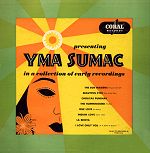 unpretentious,
and beautifully poised, emphasis in
the early recordings was on authenticity
rather than vocal gymnastics - although
there are many instances of the latter
in such pieces as "Virgenes del
Sol," "Amor Indio" "Waraka
Tusuy" and others. In such pieces,
however, accent is on octave display
rather than outré vocalism. The
music and accompaniment are simple and
so is Yma’s delivery. Hidden among all
this simplicity is a surprising range
extension - from a touched high F sharp
to a vibrant low E.
unpretentious,
and beautifully poised, emphasis in
the early recordings was on authenticity
rather than vocal gymnastics - although
there are many instances of the latter
in such pieces as "Virgenes del
Sol," "Amor Indio" "Waraka
Tusuy" and others. In such pieces,
however, accent is on octave display
rather than outré vocalism. The
music and accompaniment are simple and
so is Yma’s delivery. Hidden among all
this simplicity is a surprising range
extension - from a touched high F sharp
to a vibrant low E.
A.N. After a conversation
with Don Pierson of the Sunvirgin.com
website, it appears that there will
be a commercial release of all the Argentinean
disks on CD in the near future. Don
will be producing it and in charge of
the transfers which will be from the
original 78 rpm recordings. Although
I am not sure of the date, I suggest
that any reader interested should keep
checking regularly www.Sunvirgin.com
for any news about this new release.
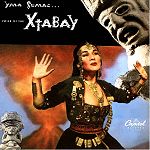 Voice
of the Xtabay (1950)
Voice
of the Xtabay (1950)
1. "Taita Inty"
(Virgin of the Sun God, Hymn to the
Sun)
2. "Ataypura"
(High Andes)
3. "Accla Taqui"
(Chant of the Chosen maidens)
4. "Tumpa!"
(Earthquake)
5. "Choladas"
(Dance of the Moon Festival)
6. "Wayra"
(Dance of the Winds)
7. "Monos"
(Monkeys)
8. "Xtabay"
(Lure of the Unknown Love)
By the time this recording
was made Yma had become a product of
the American publicity machine. Most
people get their first introduction
to Yma Sumac through this record and
it is the perfect way to discover this
unique voice. Baxter’s scoring of the
songs has an allure that seems timeless.
With hints of Ravel and Stravinsky he
managed to create the perfect support
for Yma’s distinctly idiosyncratic singing.
For her part, she traces her vocal line
with incredible virtuosity and displays
a range from G above high C to the D
below middle C – exotic, eerie, unearthly.
There are countless
great moments during these eight selections,
but probably the most stunning happens
at the mid-point of "Tumpa!"
(Earthquake). It is there that Yma sings
an ascent from the contralto F sharp
to the coloratura soprano F sharp three
octaves above with not one note out
of place. It remains one of the most
beautiful three octave ascents ever
recorded.
Other songs to look
out for include: "Taita Inty,"
(Virgin of the Sun God, a.k.a. The Hymn
to the Sun). Surely nothing better represents
Yma’s vocal ability than this staggering
vocal display. The excessive number
of high notes in this short piece (2:57)
demonstrates the comfortable height
of Yma’s voice and the song’s unusual
difficulty. Most operatic coloratura
sopranos, even high note specialists
– the acuto sfogati - would balk over
such requirements. For example "Taita
Inty" includes 16 high F’s (four
times what is needed to sing the Queen
of the Night’s Vengeance aria from Mozart’s
Die Zauberflöte), 22 high
E’s, and 29 high C's.
"Monos" (Monkeys),
Xtabay (Lure of the Unknown Love)
are also listener favorites. Of them
all, however, it is "Ataypura"
(High Andes) that remained Yma’s theme
song. This was a piece that she sang
until her last engagements and it was
also heavily scored into the 1954 Paramount
Adventure film, Secret of the Incas
in which Yma starred.
I have heard Voice
of the Xtabay thousands of times.
I know every note, every breath Yma
takes in every song and yet, even after
so many years, the album still
has the ability to thrill and amaze
me. It remains one of my Desert Island
discs.
 Legend
of the Sun Virgin (1951)
Legend
of the Sun Virgin (1951)
1. "Karibe Taki"
(Caribean Song, also known as "Alma
Tristese")
2. "Witallia"
(Fire in the Andes)
3. "Lament"
(Yma’s Lament) -)
4. "Zana"
5. "Kuyaway"
(Inca Love Song)
6. "Suray Surita"
7. "No es Vida"
8. "Mamallay"
Also recorded in 1951,
but not released until February 1956,
when the album was re-released as a
12" disc:
9. "Kon Tiki"
10. "Montana"
(Lullaby)
11. "Panarima"
12. "Ccori Canastitay"
(Golden Basket)
Yma’s next solo album
was the infamous Legend of the Sun
Virgin. Although an admirable vocal
obstacle course, the music on this recording
shows Yma’s growing preoccupation with
crowding as many vocal effects as possible
into a song’s fabric. This would settle
down after the next album. Like the
previous album, Legend of the Sun
Virgin seems to be loosely based
on the form of a vocal suite. Some songs,
like the opening "Karibe Taki,"
as well as "Suray Surita"
"Zana," and "Kon Tiki"
benefit from all this attention; being
fascinating pieces of vocal virtuosity
that bear up well to repeated hearings.
"Montana" was a piece she
kept in her repertoire for forty-six
years. A gentle lullaby, its simplicity
obviously appealed to the Peruvian.
"Kuyaway" (Incan Love Song)
is a clever, involved reworking of the
1943 "Amor Indio." Although
a stunning display of Yma’s vocal prowess,
one misses the simple beauty of the
earlier version. Vocally, a stunning
album.

Inca Taqui (1953)
1. "K’arawi"
(Planting Song)
2. "Cumbe-Maita"
(Calls of the Andes)
3. "Wak’ai"
(Cry)
4. "Incacho"
(Royal Anthem)
5. "Chuncho!"
(Forest Creatures)
6. "Llulla Mak’ta"
(Andean Don Juan)
7. "Malaya"
(My Destiny)
8. "Ripui"
(Farewell)
This album is now coupled
with Voice of the Xtabay. Recorded
in 1953, it is among Yma’s most famous
recordings and has her most famous song
– "Chuncho!" (Forest Creatures).
"Chuncho!" was a concert favorite.
Critics often detested the piece since
they truly did not know what to make
of it, but audiences were spellbound
by Yma’s bizarre, mesmerizing vocalism.
Nothing like it had ever been heard
at that time and nothing in the annals
of recorded history has equaled the
sounds Yma manages to create during
the course of this three-minute piece
of music. There is no melody to speak
of, only sounds imitative of the winds,
beasts and birds of the jungle. Program
music in the extreme, it is supported
only by Moisés’ guitar, the quena
(Peruvian flute), and native drums.
Yma’s voice takes on all sorts of shades
and colors from whispered sounds to
rough growling, to volleys of high stacatti.
And then there is her infamous "double-voiced
trill." This is actually a clever
vocal trick - an uncanny ability Yma
had to utilize a register break around
the A above high C. She would oscillate
back and forth between the notes to
form a facsimile of a trill. It is a
startling effect and once heard never
forgotten. Although she did do this
particular effect in front of audiences,
generally it took place about a third
lower. No matter where it takes place
– it is still a remarkable effect.
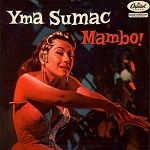 Mambo!
(1954)
Mambo!
(1954)
1. "Bo Mambo"
2. "Taki Rari"
3. "Gopher Mambo
4. "Chicken Talk"
5. "Malambo #1"
6. "Five Bottle
Mambo"
7. "Indian Carnival"
8. "Jungla"
Also recorded in 1954,
but not released until 1956:
9. "Goomba Boomba"
10. "Cha Cha Gitano"
11. "Carnavalito
Boliviano"
To this day, this album
remains one of Yma’s most popular releases.
It is a joy from the first note to the
last. Brilliantly sung, the album is
as unique as its singer - whose vocalism
is addictive. Judged by any criteria,
this is absolutely remarkable singing.
Yma is generous with the use of her
high register – all the way to brilliantly
sustained high Fs, but also descends
to rich, basso C’s. Every piece on the
album is fun and full of staggering
virtuosity. Especially popular are "Gopher
Mambo," "Taki Rari,"
and "Chicken Talk." A few
pieces, such as "Gopher Mambo"
and "Bo Mambo" have even been
used in American television commercials
and movies. As a whole, this album is
one of Yma’s most admirable efforts.
Be sure not to miss this one
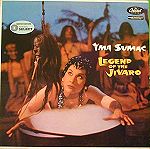 Legend
of the Jivaro (1956) (out of
print at the time of this writing)
Legend
of the Jivaro (1956) (out of
print at the time of this writing)
1. "Jivaro"
( War Cry)
2. "Sejollo"
(Whip Dance)
3. "Yawar"
(Blood Festival)
4. "Shou Condor"
(Great Condor)
5. "Suama"
(Magic)
6. "Nina"
(Fire Arrow Dance)
7. "Sansa"
(Victory Song)
8. "Hampi"
(Medicine)
9. "Sumac Sorateña"
10. "Aullay"
(Lullaby)
11. "Batanga Hailli"
(Festival)
12. "Wanka"
(The Seven Winds)
Probably the last of
Yma’s great Capitol albums – although
with qualifications. Recorded while
the singer was in the midst of personal
problems and divorce issues, the singing
occasionally sounds psychotic. The liner-notes
are offensive in their brazen attempt
to con listeners into believing that
Yma and Moisés trudged through
Amazonian Jungles to gather these slight
tunes – especially since at least one
of them appeared - in a different arrangement
- on Mambo! two years earlier!
Aside from that, Yma’s singing is certainly
strong and often amazing. One of the
loveliest things she recorded was the
final song on this album – "Song
of the Seven Winds." Using only
a voiceless "Sh" and performing
the piece as a vocalize of only one
octave, there is a lovely simplicity
to the music that is as endearing as
it is moving. "Suama" (Magic)
and Hampi (Medicine) are just odd. Despite
musical drawbacks, Yma sprinkles the
music with some delicious high D’s and
E’s and the voice is in excellent condition.
 Fuego
del Ande (1959)
Fuego
del Ande (1959)
1. "La Molina"
(The Mill Song)
2. "Flor de Canela"
(Cinnamon Flower)
3. "Gallito Caliente"
(The Hot Rooster)
4. "La Pampa y
la Puna" (The Plains and the Mountains)
5. "Dale que Dale
"(The Workers Song)
6. "Llora Corazon"
(Crying Heart)
7. "Huachina"
(Enchanted Lake)
8. "La Perla de
Chira" (The Pearl)
9. "Mi Palomita"
(My Pigeon)
10. "Virgenes
del Sol"
11. "Gallito Ciego"
12. "Clamor"
This has never been
one of my favorites. It is a program
of South American folk and popular songs.
Although authentic that virtue is completely
ruined by the grotesque arrangements
used – some of which are just embarrassing.
Also, Yma’s singing is just not that
interesting. Yma was always a singer
of elegance and dignity and to be surrounded
by such drivel is insulting. It is unfortunate
that Legend of the Jivaro is
out of print while this tacky album
remains in print. Many listeners, on
hearing this album will assume that
Yma’s vocal abilities were in decline
by this time (1959) – but nothing was
further from the truth. Within two years
she was touring Russia and Eastern Europe
in a huge tour that has since become
legendary.
(In December of 2006,
ESP Records released "Yma Sumac
- Live in Concert - the Russian Tour."
[ESP CD 4029] an excellent re-mastering
of a concert that has been circulating
among Sumac buffs for decades but in
inferior sound. Although I do not have
the space to discuss it here, anyone
interested in Yma Sumac should get this
fascinating disc – available from Amazon.com)
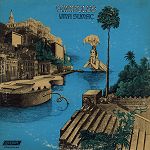 Miracles
(1971) (now known as Yma Rocks)
Miracles
(1971) (now known as Yma Rocks)
1. "Remember"
2. "Medicine Man"
3. "Let me Hear
You" (Lord, Lord, Lord)
4. "Tree of Life"
5. "Flame Tree"
6. "Zebra"
-
7. "Azure Sands"
8. "Look Around"
9. "Magenta Mountain"
10. "El Condor
Pasa" -
Also recorded in 1971,
but not released until 1998’s YMA
ROCKS!
11. "Parade"
12. "Savage
Rock" (originally called "Moses")
Originally released
by London Records (Decca) in 1971, this
bizarre hard-rock album was withdrawn
within a couple of months due to a law
suit Yma brought against London Records
concerning inaccurate liner-notes. It
remained out of print for decades. Originally
the album was produced by three business
men from New York who sold the recording
to Decca. One of them, Robert Covais,
who owned the master tape, had it re-mixed
and re-released on CD in 1998 by JOM
Records. A brilliant album and mix it
can still be bought from www.sunvirgin.com.
– one of the main Yma Sumac web sites.
The first reuniting of Yma Sumac and
Les Baxter since Voice of the Xtabay,
the album offers the listener much that
is high on camp but also high on listening
rewards. The music may be a bit uninspired
but Yma’s singing certainly is not.
Still in command of over three octaves
the new technology allows one to hear
the improvisations of three or four
Sumacs at the same time. The two favorite
tracks are "Remember", a dynamic,
tour de force that recalls Yma’s multi-octave
singing from twenty years earlier and
"Magenta Mountain," the ballad
of the album which boasts some sweet
warbling by Yma over simple guitar accompaniment.
It ends with her surprising the listener
by spinning an exquisite, pianissimo
high E flat. Everyone should have this
album.
I hope that I have
managed to give you at least a hint
of the wonderful experiences Yma Sumac’s
albums offer the listener. If you are
not familiar with her work do give her
a try. I think you will be surprised.
She and her music still have the ability
to sweep one off into distant lands
of secret ritual, ruined temples and
steamy jungles.
One thing does need
to be understood, however. When Yma
Sumac made her recordings they were
meant to be listened to without distraction.
They are mood compositions not music
to accompany chores or while multi-tasking
as is so often the case today. In creating
atmosphere through countless vocal effects,
she prompts the listener to use their
imagination to form their personal mental
scenario of what she was portraying.
Much of Yma Sumac's repertoire was program
music - music where the only effect
sought is the creation of a mood or
atmosphere, the listener guided by titles
or program notes, a popular music version
of classical composers' tone poems and
much symphonic literature. Its premise
is similar to the days before television,
when listeners would crowd around the
radio for such programs as "The
Shadow" and "Inner Sanctum,"
creating their own private scenarios
guided by the words of the actors on
the radio.
Succeeding generations
have grown up with the advent of television
which quickly superseded radio’s importance.
It was no longer necessary to create
a scenario - television provided that.
Yma Sumac’s music, however, requires
mental participation. Only then is it
possible for the listener’s mind to
wander to a new land and to reap the
full benefits of her singing.
In the end, today’s
listener should approach Yma Sumac’s
singing and recordings as theatrical
entertainment, unique in its presentation
and a product of its era. It is a product
with the simplest of messages - enjoy.
Nicholas E. Limansky
July 2007

